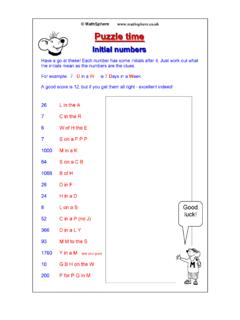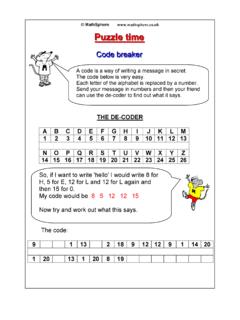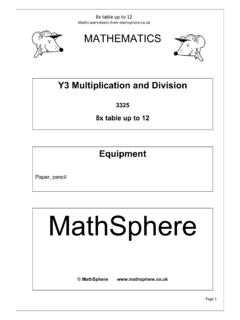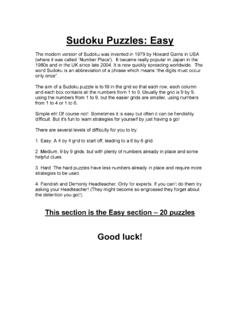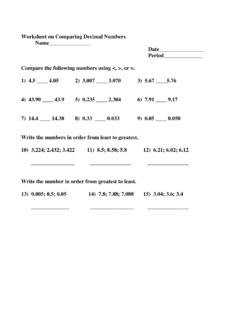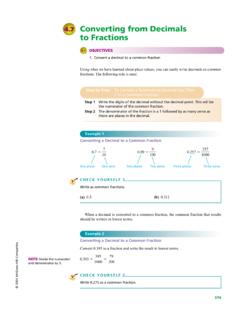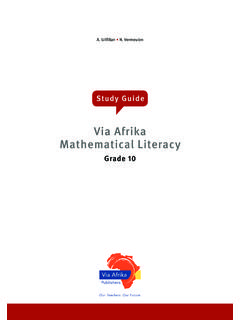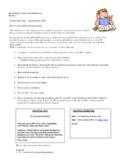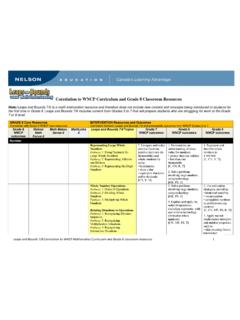Transcription of Maths worksheets from mathsphere .co.uk MATHEMATICS
1 Year 4 MATHEMATICS Programme of Study Maths worksheets from MATHEMATICS . Programme of Study Year 4 Number and Place Value Here are the statutory requirements: Number and place value Pupils should be taught to: count in multiples of 6, 7, 9, 25 and 1000. find 1000 more or less than a given number count backwards through zero to include negative numbers recognise the place value of each digit in a four-digit number (thousands, hundreds, tens, and ones). order and compare numbers beyond 1000. identify, represent and estimate numbers using different representations round any number to the nearest 10, 100 or 1000. solve number and practical problems that involve all of the above and with increasingly large positive numbers read Roman numerals to 100 (I to C) and know that over time, the numeral system changed to include the concept of zero and place value.
2 Below is a list of mathsphere modules covering the above requirements. Number and place value (94 pages including titles, concepts and answers). 1. Counting in multiples of 7, 8, 9 and 25. (10 pages). 2. Find 1, 10, 100 or 1000 more. (16 pages). 3. Read and write whole numbers. Partition. (14 pages). Page 1. Year 4 MATHEMATICS Programme of Study Maths worksheets from Number and place value (continued). 4. Revise vocabulary for comparing and ordering numbers. (13 pages). 5. Recognise and order negative numbers. (13 pages). 6. Extend number sequences. (12 pages). 7. Revise rounding numbers. (11 pages). 8. Roman Numerals. (5 pages). Page 2. Year 4 MATHEMATICS Programme of Study Maths worksheets from Programme of Study Year 4 Addition and Subtraction Here are the statutory requirements: Addition and Subtraction Pupils should be taught to: add and subtract numbers with up to 4 digits using the formal written methods of columnar addition and subtraction where appropriate estimate and use inverse operations to check answers to a calculation solve addition and subtraction two-step problems in contexts, deciding which operations and methods to use and why.
3 Below is a list of mathsphere modules covering the above requirements. Addition and Subtraction (140 pages including titles, concepts and answers). 1. Revise addition and its relationship to subtraction. (15 pages). 2. Revise subtraction and its relationship to addition. (12 pages). 3. Add or subtract the nearest multiple of 10 and adjust. (13 pages). 4. Use the relationship between addition and subtraction. Add several numbers. (21 pages). 5. Use knowledge of addition and subtraction and place value. (19 pages). 6. Use known number facts to add and subtract mentally. (18 pages). 7. Refine and use efficient written methods of addition. (13 pages). 8. Formal written addition of 4-digit numbers.
4 (7 pages). 9. Refine and use efficient written methods of subtraction. (12 pages). 10. Formal written subtraction of 4-digit numbers. (10 pages). Page 3. Year 4 MATHEMATICS Programme of Study Maths worksheets from Programme of Study Year 4 Multiplication and Division Here are the statutory requirements: Multiplication and division Pupils should be taught to: recall multiplication and division facts for multiplication tables up to 12 12. use place value, known and derived facts to multiply and divide mentally, including: multiplying by 0 and 1; dividing by 1; multiplying together three numbers recognise and use factor pairs and commutativity in mental calculations multiply two-digit and three-digit numbers by a one-digit number using formal written layout solve problems involving multiplying and adding, including using the distributive law to multiply two digit numbers by one digit, integer scaling problems and harder correspondence problems such as n objects are connected to m objects.
5 Below is a list of mathsphere modules covering the above requirements. Multiplication and Division (188 pages including titles, concepts and answers). 1. 7x table. (12 pages). 2. 9x table. (14 pages). 3. 11x and 12x tables up to 12. (13 pages). 4. Tables: speed sheets. (21 sheets). 5. More multiplication facts. Doubling and halving. (11 pages). 6. Multiply and divide mentally. (13 pages). 7. Multiply and divide by 10 and 100 and 1000. (16 pages). Page 4. Year 4 MATHEMATICS Programme of Study Maths worksheets from Multiplication and Division (continued). 8. Develop written methods of multiplication. (9 pages). 9. Short multiplication 2-digits by 1-digit. (8 pages). 10. Short multiplication 3-digits by 1-digit.
6 (9 pages). 11. Revise understanding of division. (12 pages). 12. Understand remainders. (19 pages). 13. Develop written methods of division. (8 pages). 14. Formal method of short division with no remainders. (7 pages). 15. Formal method of short division with remainders. (6 pages). 16. Odd and even. Multiples and tests of divisibility. (10 pages). Page 5. Year 4 MATHEMATICS Programme of Study Maths worksheets from Programme of Study Year 4 Fractions Here are the statutory requirements: Fractions Pupils should be taught to: recognise and show, using diagrams, families of common equivalent fractions count up and down in hundredths; recognise that hundredths arise when dividing an object by a hundred and dividing tenths by ten.
7 Solve problems involving increasingly harder fractions to calculate quantities, and fractions to divide quantities, including non-unit fractions where the answer is a whole number add and subtract fractions with the same denominator recognise and write decimal equivalents of any number of tenths or hundredths 1 1 3. recognise and write decimal equivalents to /4 ; /2; /4. find the effect of dividing a one- or two-digit number by 10 and 100, identifying the value of the digits in the answer as units, tenths and hundredths round decimals with one decimal place to the nearest whole number compare numbers with the same number of decimal places up to two decimal places solve simple measure and money problems involving fractions and decimals to two decimal places.
8 Below is a list of mathsphere modules covering the above requirements. Fractions (101 pages including titles, concepts and answers). 1. Revise equivalent fractions. (12 pages). 2. Count in hundredths. (4 pages). Page 6. Year 4 MATHEMATICS Programme of Study Maths worksheets from Fractions (continued). 3. Find fractions of numbers or quantities. (7 pages). 4. Identify pairs of fractions that total 1. (10 pages). 5. Add and subtract fractions. (12 pages). 6. Use decimal notation. Order decimal fractions. (12 pages). 7. Decimal fractions. (12 pages). 8. Recognise equivalence between decimals and fractions. (13 pages). 9. Divide by 10 and 100. (7 pages). 10. Solve problems involving money.
9 (8 pages). 11. Round decimals. (4 pages). Page 7. Year 4 MATHEMATICS Programme of Study Maths worksheets from Programme of Study Year 4 Measurement Here are the statutory requirements: Measurement Pupils should be taught to: convert between different units of measure ( kilometre to metre; hour to minute). measure and calculate the perimeter of a rectilinear figure (including squares) in centimetres and metres find the area of rectilinear shapes by counting squares estimate, compare and calculate different measures, including money in pounds and pence read, write and convert time between analogue and digital 12 and 24-hour clocks solve problems involving converting from hours to minutes; minutes to seconds; years to months; weeks to days.
10 Below is a list of mathsphere modules covering the above requirements. Measurement (87 pages including titles, concepts and answers). 1. Standard metric units of measurement. (11 pages). 2. Units to estimate and measure. (8 pages). 3. Suggest suitable measuring equipment and record results. (20 pages). 4. Measure and calculate the perimeter and area of simple shapes. (16 pages). 5. Measurement investigation. (4 pages). 6. Solve problems involving length, mass or capacity. (7 pages). 7. Using the 24-hour clock. (14 pages). 8. Solve problems involving time. (7 pages). Page 8. Year 4 MATHEMATICS Programme of Study Maths worksheets from Programme of Study Year 4 Geometry Here are the statutory requirements: Geometry Properties of shapes Pupils should be taught to: compare and classify geometric shapes, including quadrilaterals and triangles, based on their properties and sizes identify acute and obtuse angles and compare and order angles up to two right angles by size identify lines of symmetry in 2-D shapes presented in different orientations complete a simple symmetric figure with respect to a specific line of symmetry.


